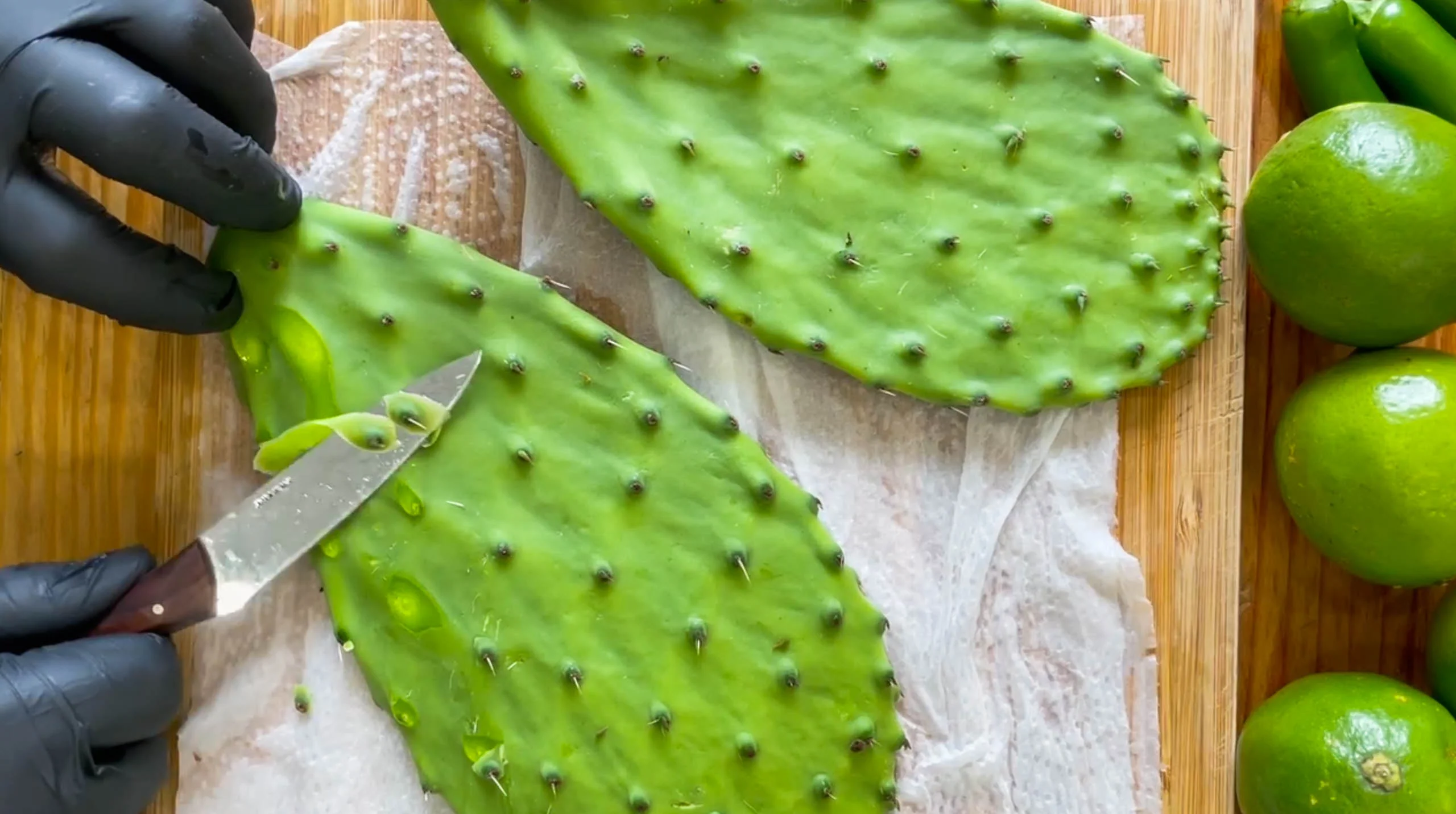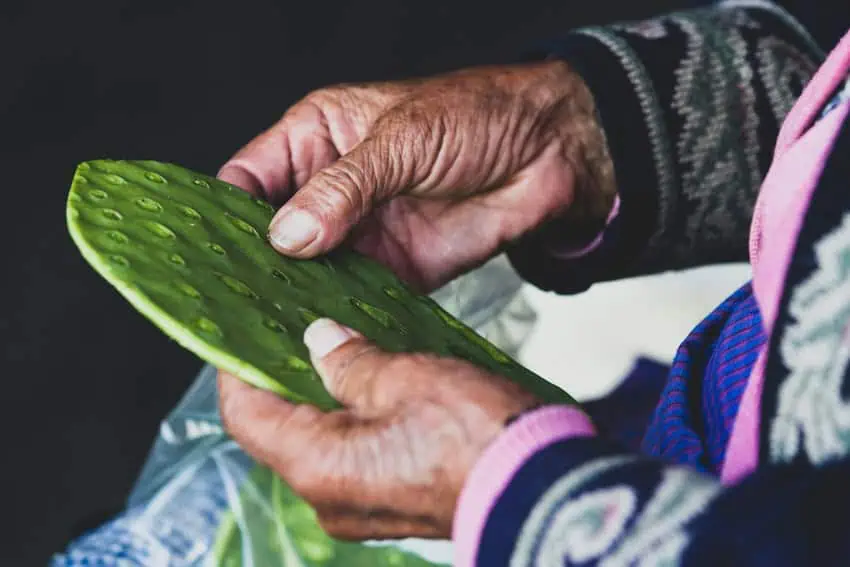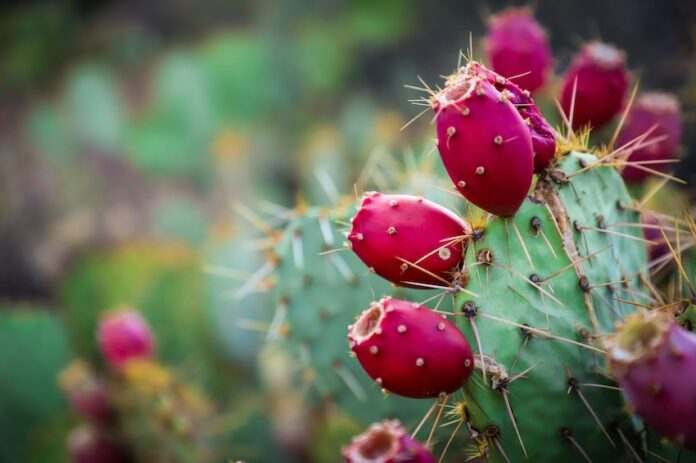Amigos, you ask and Taste of Mexico delivers. On Instagram, Aparigraha asked us to do a series about vegetarian food in Mexico, so today we’ll talk about the edible plant that helped shape this nation: the nopal.
Did nopales really shape a nation though?

Have you ever looked closely at our national emblem? It’s a reminder of the founding of Aztec civilization. According to legend (albeit one that is now much distorted and oversimplified) the Mexica were searching for a place to settle. Guided by Huitzilopochtli, the god of the Sun and war, they were to found their kingdom where they saw an eagle devouring a serpent atop a nopal cactus. They “found” this sign in the middle of Lake Texcoco.
For the Mexica, the nopal cactus was considered a sacred tree that linked the three realms: its roots connected to the underworld, the cactus pads represented earthly existence, and the tunas (the prickly red fruits that grow on the nopal), seen as sacred hearts, connected to the thirteen heavens and nourished the sun god Hutzilopochtil.
A staple in times of crisis
The symbolic importance of the nopal is no coincidence. This plant grows throughout the country and thrives in harsh conditions, making it a symbol of resilience. It has been consumed for over 20,000 years and domesticated for nearly 9,000 years, serving as food, drink, and medicine.
Rich in fiber, vitamins A and C, minerals, and antioxidants, the nopal has played a vital role in maintaining a balanced diet when combined with other ingredients. Furthermore, it can be consumed in various forms.
There are over 200 types of nopal, with 93 found in Mexico and 62 being endemic. The most popular variety is Milpa Alta.
View this post on Instagram
Nopal as medicine
Mexica warriors ate nopal with blood to gain strength before important battles. Every 52 years, during the New Fire ceremony, dried nopal was burned to prevent the end of the universe.
The mucilage from nopal, known as “slime,” is used for pain relief in burns and wounds. The tunas act as electrolytes and provide a natural alternative to Pepto Bismol. Brewing nopal flowers as tea can help regulate blood pressure. If you have diabetes, nopales are your best ally because they help to regulate sugar levels in the bloodstream.
Nopal in daily life
The mucilage from the nopal cactus was crucial in the construction of houses, as it helped adobe bricks adhere to one another. Additionally, it played a role in purifying water in canals and in fixing pigments in textiles and on walls.
Furthermore, the nopal served as a habitat for the cochineal insect, which produced a distinctive red dye. This dye was so valued that it was used in the artworks of renowned painters such as Rembrandt and Van Gogh.

Nopal, the superfood
Amigos, this truly represents the Taste of Mexico. On average, each Mexican consumes about 6.4 kg of nopal per year. We enjoy it in various dishes, including salads, tacos, soups, pickled with chiles, grilled, in juices, and alongside stews. Recently, there have been some exciting innovations: you can now find dehydrated nopal spicy snacks, ice creams, tortillas, and even nopal supplements.
Every 100 grams of nopal contains just 16 calories, making it an appealing option for those looking to lose weight. Remarkably, 60% of its weight is pure fiber. Its mucilage acts as a prebiotic, which helps improve gut health. If you experience trouble sleeping, you’ll be glad to know that nopal provides magnesium, calcium, potassium, vitamin C, vitamin A, and a wealth of antioxidants.
How do I add it to my diet?
There are many ways to enjoy it! The most common is as a side to a stew. However, another easy way to use it is as a substitute for tortillas or dishes made with corn masa, such as tlacoyos, sopes, or gorditas.
Nopal Huarache Recipe
Ingredients:
Optional:
Instructions:
Remove the spines and rinse the nopales thoroughly.
Heat a skillet, griddle, or grill over medium-high heat. Season the nopales with salt and grill on both sides until they change color. You can add a bit of oil if you like.
Sauté the mushrooms or tofu with garlic and onion.
- Place each grilled nopal on a plate.
- Spread a layer of refried beans on the nopal.
- Add your chosen topping.
- Add fresh cheese or tofu as desired.
- Garnish with shredded lettuce, avocado slices, and salsa.
If you’re vegan or vegetarian (but especially if you’re not) I sincerely hope that you incorporate nopales in your everyday meals. Remember, whenever you make a recommendation or request, we are always attentive to your messages.
María Meléndez is a Mexico City food blogger and influencer.
